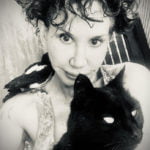MetaStellar had a visitor last week over at our MetaStellar YouTube channel — best-selling sci-fi author Steven Barnes.

He was interviewed by Elizabeth King and Andrea Goyan, the hosts of our Long-Lost Friends segment. Barnes is a New York Times bestselling author of such books as Lion’s Blood, the Star Wars novel The Cestus Deception, and the Star Trek novel Far Beyond the Stars. He’s also co-written books with Larry Niven and Jerry Pournelle. Oh, and he’s written for a few TV shows you might have heard of — The Outer Limits, The New Twilight Zone, and Stargate SG-1, among others.
So he knows what he’s talking about when it comes to writing careers.
But he also has experience in teaching people how to become writers. Thousands of people. He taught writing at UCLA. He has also taught courses elsewhere, and some are available on his website.
So here’s his guaranteed six-step plan to becoming a successful writer.
Step 1: Commit to writing one sentence a day
“Most people think that they have to do some extreme amount of something in order to accomplish anything,” he told King and Goyan. “If I can’t write five pages a day or ten pages a day, I’m not a writer. No, no, no. If you can do one sentence a day, you can get there — because the problem is overcoming the emotional resistance. The inertia.”
You can stop after one sentence and consider the day a success.
“But you will find yourself wanting to do more because now there’s no guilt attached to it,” he said. “There’s no fear. The only work is one sentence — the rest is playing.”
Once you do that, you’re a writer, Barnes said. “That’s the first step.”
Step 2: Write one to four short stories a month
The second step is to write short stories, anywhere from one to four stories a month.
“Short stories are where it’s at,” he said.
It’s similar to running a marathon. That’s what writing a novel is like — like running a marathon.
“Nobody trains to run a marathon by running marathons,” he said.
Instead, people start out by running around the block.
“Short stories are running about the block,” he said.
Step 3: Finish what you have written and submit it for publication
The next step is to finish these stories and start sending them out.
“If you write it, and finish it, but don’t submit it — that’s another form of writer’s block,” he said.
Sending out stories also gets you used to dealing with rejection. Meanwhile, writing a lot of stories ensures that you don’t dwell on those rejections too much.
“When you send something out, you’re immediately going on to your next work,” he said. “So by the time it gets rejected you’re halfway through the next work at least, possibly two or three stories down the road.”
Step 4: Don’t rewrite unless an editor asks you to
It’s okay to spend time revising stories, as long as you’re still producing one to four stories a month, he said.
“If I spend five years on a story, that’s fine, as long as I’m spending on a couple of days on some other stories,” he said. “Because I’ve got to get at least one story a month out the door.”
It’s getting the process down that’s the important step, he said, not the quality of the individual stories.
“If you focus on getting a story perfect, you get obsessive compulsive disorder,” he said. “The story will never be perfect because the more you rewrite the sharper your perceptions get. You will never get there. You will always see imperfections.”
Just do your best, and let the market decide whether it’s worthwhile.
And this will take time, he added.
First, you’ll get form letter rejections. Then form letters with personal notes on them. Then letters. Editors might suggest changes.
“Pay attention to that,” he said. “Make the change.”
Step 5: Read ten times as much as you write
Writers should be reading other writers. Lots of other writers.
“If you want to write one story a month, you need to be reading at least ten stories a month,” he said. “If you want to write four stories a month, you should be reading at least 40. That’s the work.”
And read books one step up from the books you’re writing.
“If you want to write comic books, read popular fiction,” he said. “If you want to write popular fiction, read bestsellers. If you want to write bestsellers, read classics.”
Don’t worry about accidentally copying.
“You learn how to walk, how to talk, how to ride a bicycle, and everything else, by imitation,” he said. “Imitation is the fastest way to learn anything.”
Step 6: Repeat this process one hundred times
When Barnes first started out, he said he was scared of all the rejections.
“I’d been sending stuff out and not publishing anything,” he said. “Then I looked at the writers who I admired.”
They were writing 20 or 30 stories before their first one was published. Sometimes 40.
“So I said, if I really want to do this, let me give myself some breathing room,” he said. “I’m not even going to ask the question, ‘Can I do this?’ until I have run 100 stories through the process.”
It took 23 stories, he said.
“And not a single one of my students has ever followed this process and made it past story 34 without getting published,” he said.
And that’s it. You’re a published writer. You made it.
Now you can work your way up to longer works and to finding an agent.
“Don’t be afraid of your fear,” he said.
Watch the full interview below.



